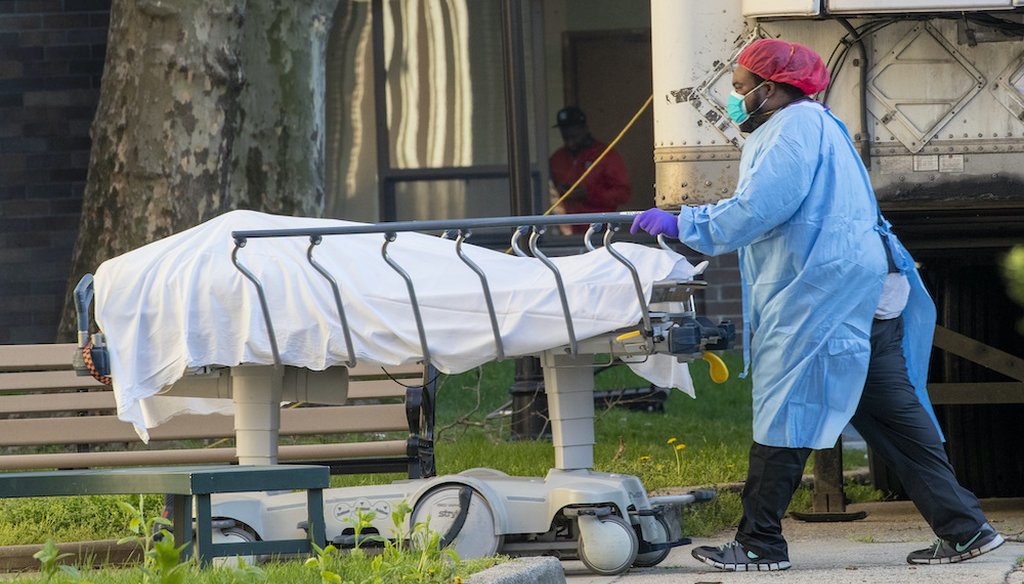Get PolitiFact in your inbox.

Medical personnel transport a body from a refrigerated container at Kingsbrook Jewish Medical Center. (AP Photo/Mary Altaffer)
COVID-19 skeptics say there’s an overcount. Doctors in the field say the opposite
If Your Time is short
-
Patients who test positive for the coronavirus are likely being included in nationwide death counts.
-
But doctors say that’s actually an undercount because of a lack of available testing, among other factors.
-
Coronavirus is more difficult for people with pre-existing heart and lung problems, which could lead to respiratory or cardiac arrest.
On the day that doctors and nurses in New York City treated over 1,500 new COVID-19 patients, conservative pundit Candace Owens claimed that deaths from the pandemic coronavirus have been inflated.
"Apparently, doctors and nurses around the world are wondering why no one is dying from heart attacks or strokes any more, Owens tweeted April 6. "Flu and pneumonia deaths also went off a cliff. Turns out everyone is only dying of coronavirus now. Gee, I wonder why."
An exaggerated death count is a persistent talking point. On April 4, Owens tweeted "State departments of Public Health are reporting the number of deaths BEFORE the medical examiners have even concluded the cause of death," she said. "There would be no legitimate way to report how many people die daily."
Are Owens’ claims correct? We asked her for evidence but did not hear back. What we found is that her statement is at odds with doctors, who say the data, in fact, reflects an undercount.
Here’s why the details of death reporting back up the doctors more than the pundits.
Complicating factors aren’t so complicated
Owens is wrong that only medical examiners determine a person’s cause of death. Formal death certificates start with the attending doctor. The Centers for Disease Control and Prevention tells physicians to list the immediate cause of death, such as cardiac or respiratory arrest, and then proceed to the underlying disease that caused the heart or breathing to stop.
The underlying cause should be "the disease or injury which initiated the train of morbid events leading directly to death."
If a person showed up in the emergency room with COVID-19 symptoms and a heart attack, there could be a judgement call as to what goes in as the underlying cause. But Dr. Marcus Plescia, chief medical officer for the Association of State and Territorial Health Officials, said there would be strong argument to note the key role of COVID-19.
"I would put COVID-19 as the primary cause," Plescia said. "Because most likely, the heart attack was caused by the fever or a difficulty in breathing."
There’s no question that the virus lands harder on people with pre-existing heart and lung problems.
"If those individuals are positive for COVID-19 and have symptoms, COVID-19 is typically being listed on the death certificate as the cause of death, with their other diseases listed as contributory," said Dr. Sally Aiken, president of the National Association of Medical Examiners.
Aiken added, "it is not a conspiracy, or any different than what occurs during non-COVID-19 times."
The CDC said in a statement that if it works with death certificate data, it will add a death to the COVID-19 tally regardless on which line the disease is listed.
Death certificates and COVID-19 reports are different
It’s important to note that death certificates are not the only — or even primary way — the states report coronavirus deaths.
New York, which to date accounts for over 40% of deaths nationwide, does not use death certificate data for reporting COVID-19 fatalities. When a person with the virus dies, hospitals or nursing homes tell their local health officials who then notify the state health department, which in turn sends a report to Washington.
Providers in New York use this form to record the death, and unlike a full death certificate, it provides just one place to note the disease.
This quick reporting form lacks the details that go into a death certificate. Like seasonal flu, COVID-19 is what is known as a nationally notifiable disease. Heart attacks and strokes fall into the larger group of diseases that are not tracked in real time. The system to gather COVID-19 data is designed to help public health officials track what is happening as quickly as possible.
Death certificates are processed at a slower pace.
Why doctors say we’re likely undercounting, not overcounting deaths
There are several reasons COVID-19 victims might not make it into the quick reporting system.
"Doctors won't record a death until they are certain," Plescia said. "And with the high volume of cases, they may not be reporting because they move on to other things."
Plescia added that if a person dies on the way to the hospital, or very soon after, they won’t be tested for the virus.
"There’s nothing any more you can do for them," he said.
Aiken said if the person had no symptoms of the coronavirus, her department wouldn’t test them.
"These decedents are not being tested for COVID-19 as a matter of course," Aiken said.
Given the scarcity of tests, Aiken said, that’s generally true across the country.
Plescia said, "if there’s any error, it’s in under-reporting."
Aiken echoed the point, and said it applies to death certificates as well.
"COVID-19 deaths will likely be under-reported on death certificates and not over-reported," Aiken said. "This will be especially true as deaths that occur in homes, and not the hospital, mount."
Our ruling
Owens said that "everyone is dying of coronavirus now." Her post reflects a misunderstanding of how COVID-19 interacts with other health conditions and how deaths are reported.
The physicians we reached said it’s important to track when COVID-19 triggers a pre-existing heart or lung condition. To meet the need for immediate data, New York sends the CDC summaries of COVID-19 deaths, and not the full death certificates.
People familiar with the tracking system say some victims go uncounted. They told us that the limited supply of testing, the pace of work at hospitals and deaths that take place outside any medical facility point to an underreporting of COVID-19 deaths, not an overreporting.
We rate this claim False.
Our Sources
Candace Owens, tweet, April 6, 2020
Candace Owens, tweet, April 4, 2020
Candace Owens, Facebook post, March 29, 2020
Brit Hume, tweet, April 7, 2020
Johns Hopkins University, Coronavirus resource center, accessed April 13, 2020
New York City Health Department, COVID-19 data, accessed April 13, 202
State of New York Health Department, COVID-19 fatalities, accessed April 13, 2020
National Vital Statistics System, Guidance for Certifying Deaths Due to Coronavirus Disease 2019 (COVID–19), April 2020
U.S. Centers for Disease Control and Prevention, Coronavirus Disease (COVID-19) Death Data and Reporting Guidance, April 2020
Centers for Disease Control and Prevention, Pneumonia and flu mortality, April 2, 2020
New York Times, Where Have All the Heart Attacks Gone?, April 6, 2020
New Haven Register, Yale New Haven sees rise in coronavirus patients slowing, April 7, 2020
Lead Stories, COVID-19 NOT Being Blamed For Deaths Primarily Due To Unrelated Causes, April 1, 2020
Statement, press office, U.S. Centers for Disease Control and Prevention, April 10, 2020
Email exchange, Jonah Bruno, spokesman, New York State Department of Health, April 11, 2020
Interview, Marcus Plescia, chief medical officer, Association of State and Territorial Health Officials, April 10, 2020
Email exchange, Sally Aikens, president, National Association of Medical Examiners, chief medical examiner, Spokane Country, Washington, April 10, 2020
Interview, Jonathan Arden, board chair, National Association of Medical Examiners, principal, Arden Forensics, April 9, 2020
Email exchange, Cathy Lewis, senior manager, National Communications American Heart Association, April 10, 2020
Email exchange, Harlan Krumholz, director, Yale New Haven Hospital Center for Outcomes Research and Evaluation, April 10, 2020
Browse the Truth-O-Meter
More by Jon Greenberg
COVID-19 skeptics say there’s an overcount. Doctors in the field say the opposite
Support independent fact-checking.
Become a member!
In a world of wild talk and fake news, help us stand up for the facts.
























































